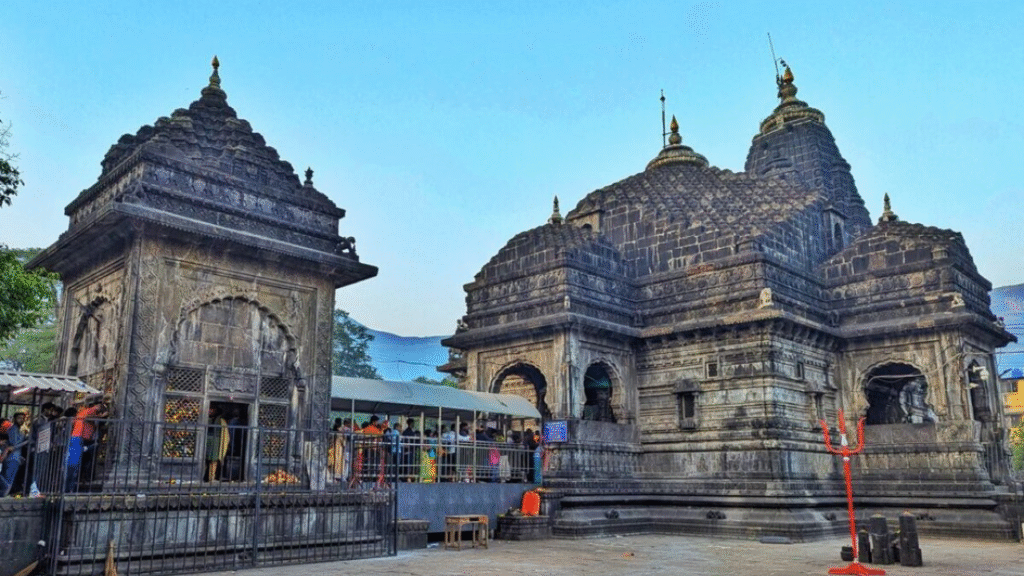Located in the serene town of Trimbak near Nashik, Maharashtra, the Shri Trimbakeshwar Shiva Temple is one of the twelve Jyotirlingas of Lord Shiva in India. Revered as a highly spiritual and ancient center, it draws pilgrims and seekers from across the world who come in search of moksha (liberation), blessings, and divine peace.
The temple is situated at the foot of the Brahmagiri Hills, which are believed to be the origin of the sacred Godavari River. Every corner of this temple resonates with timeless legends, unique rituals, and architectural elegance that set it apart as one of the holiest Shiva temples in India.
| Temple Name | Shri Trimbakeshwar Shiva Temple |
| Location | Trimbak, near Nashik, Maharashtra |
| Deity | Lord Shiva (Jyotirlinga with Trimurti faces: Brahma, Vishnu, Shiva) |
| Significance | One of the 12 Jyotirlingas; believed to grant moksha and cure doshas |
| Unique Feature | Jyotirlinga has three faces; eroding over time due to abhishekam |
| River Origin | Source of Godavari River at Brahmagiri Hills nearby |
| Key Rituals | Rudra Abhishek, Kaal Sarp Dosh Nivaran, Pitru Dosh Nivaran, Narayan Nagbali |
| Major Festivals | Mahashivratri, Shravan Maas, Kumbh Mela, Kartik Poornima |
| Architecture | Maratha style; black basalt structure built by Peshwa Nanasaheb |
| Temple Timings | 5:30 AM – 9:00 PM |
| Dress Code | Traditional attire; men wear dhotis to enter sanctum |
| Entry Fee | Free (special poojas are chargeable) |
| How to Reach | By road (from Nashik), rail (Nashik Road), air (Nashik Ozar or Mumbai) |
| Nearby Attractions | Brahmagiri Hills, Anjaneri Hills, Goraknath Gufa, Ramkund |
| Spiritual Benefits | Moksha, dosha remedies, peace of mind, karmic relief |
Mythology and Spiritual Significance
According to Hindu mythology, the Trimbakeshwar temple is where Lord Shiva appeared as a Jyotirlinga to fulfill the prayers of Sage Gautama. The sage had unknowingly committed the sin of killing a cow (go-hatya) and performed penance to cleanse himself. Pleased by his devotion, Shiva not only granted him liberation but also allowed the sacred river Godavari to originate from the nearby Brahmagiri Hills.
The word Trimbakeshwar is derived from “Tri” meaning three and “ambaka” meaning eyes, indicating the three-eyed form of Lord Shiva. The linga here is unique because it has three faces—representing Brahma, Vishnu, and Shiva, symbolizing the Trimurti (trinity) of creation, preservation, and destruction. This makes Trimbakeshwar distinct from all other Jyotirlingas.
Temple Architecture
The present-day temple was constructed in the 18th century by the Peshwa ruler Nanasaheb. Built using black basalt stone in Hemispherical Maratha-style architecture, the temple exudes grandeur and simplicity at once. The shikhara (temple tower) is ornately carved, and the sanctum is adorned with finely sculpted stone reliefs of various Hindu deities.
A notable feature is the Kushavarta Kund, a sacred tank built by Shrimant Raghunathrao Peshwa, considered the symbolic origin of the Godavari River. Pilgrims take a holy dip here before entering the sanctum, believing it washes away sins.
Inside the garbhagriha (inner sanctum), the Jyotirlinga sits low in a pit and is covered with a silver mask of the trinity. Only male devotees are allowed to enter the sanctum to perform abhishek (ritual bathing). The daily rituals include chanting of Rudra Abhishek, Laghu Rudra, and Maha Rudra by Vedic priests.
Unique Religious Practices
Unlike most temples, the Jyotirlinga at Trimbakeshwar is eroding due to excessive water abhishek, and devotees believe this symbolizes the cycle of life and death. To prevent its degradation, the actual Linga is covered with a jeweled crown and only displayed on special occasions—especially Mondays and Mahashivratri.
Trimbakeshwar is also a center for Kaal Sarp Dosh Nivaran Pooja, Narayan Nagbali, and Pitru Dosh rituals, making it an important pilgrimage site for people looking to rectify ancestral karma and astrological afflictions. Devotees often stay for several days to complete these Vedic rituals under the guidance of temple priests.
Festivals and Celebrations
The most important festival celebrated here is Mahashivratri, where thousands of devotees throng the temple to perform night-long prayers and abhisheks. The temple remains open throughout the night with elaborate rituals and chanting.
Another major celebration is the Kumbh Mela, which occurs once every 12 years in Nashik. During this time, Trimbakeshwar becomes one of the key bathing sites, and millions of pilgrims take a dip in the Godavari River to attain salvation.
Other important events include:
- Shravan Maas (July–August): Month-long Shiva worship with daily processions.
- Kartik Poornima: Holy bath and deep daan (lamp offerings).
- Ganesh Chaturthi and Ram Navami: Celebrated with cultural programs and spiritual discourses.
Spiritual Benefits of Visiting Trimbakeshwar
Devotees believe that offering prayers at Trimbakeshwar grants:
- Freedom from sins and karmic cycles
- Success in blocked endeavors
- Ancestral peace and moksha
- Remedies for planetary doshas
- Spiritual purification and inner peace
The temple is often visited by saints, yogis, and spiritual seekers who spend time in meditation on Brahmagiri Hills and the riverbanks.
Visiting Information and Tips
- Location: Trimbak town, 28 km from Nashik, Maharashtra
- Timing: 5:30 AM – 9:00 PM
- Dress Code: Modest, traditional attire is preferred. Men are required to wear dhotis to enter the sanctum.
- Entry Fee: Entry is free; special poojas are chargeable
- Photography: Not allowed inside the inner sanctum
How to reach:
- By Road: Easily accessible from Nashik via bus, cab, or private vehicle
- By Train: Nearest railway station is Nashik Road (35 km)
- By Air: Nearest airport is Nashik Ozar Airport (40 km) or Mumbai International Airport (180 km)
Accommodations ranging from simple dharamshalas to mid-range hotels are available nearby.
Nearby Attractions
- Brahmagiri Hills: Trek to the origin of Godavari River
- Anjaneri Hills: Believed to be the birthplace of Lord Hanuman
- Goraknath Gufa: Ancient cave associated with Gorakhnath yogis
- Neel Parbat and Ramkund: Sacred sites on the Godavari in Nashik



